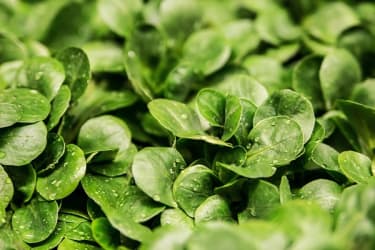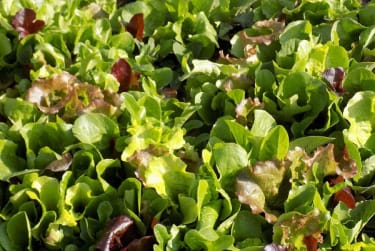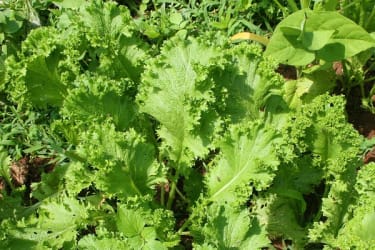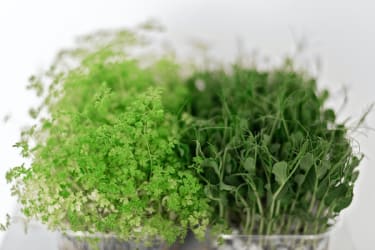9 Different Types of Salad Greens (and How Best to Use Them)
9 Different Types of Salad Greens (and How Best to Use Them)
You know that lettuce is a great salad green. But what about all of the other types of salad greens out there? There are more offerings than ever in supermarket produce aisles and on farmers market tables. Here, we highlight some of the most popular and tasty greens, many of which can form the base of wonderful main courses in their own right.
One note on all of these greens: Keep them in your refrigerator’s crisper drawer, which is designed to maintain ideal moisture levels. And if your humidity level is adjustable, keep it at a high humidity to do right by your greens.

1. Spinach
This familiar green needs no introduction, but we will point out that there’s a big difference between regular and baby spinach. The former’s leaves are larger and stiffer, and they’re an ideal match for heavy add-ins such as chopped hard-boiled egg and crumbled bacon. Treat baby spinach as you would any other small green—light dressings, small mix-ins—and you can’t go wrong.

2. Chard
Also known as Swiss chard, this beautiful veg comes in a variety of colors. The stalks and leaf veins range from pink or red to white or yellow. Despite this wide array, they all taste pretty much the same: mild, sweet, and earthy, with just a touch of bitterness. It’s milder-tasting than spinach, and it takes well to lemon and Parmesan.

3. Chicory
Chicories come in a number of varieties, including endive, escarole, frisée, and radicchio. They all have a bitter flavor—think of them as stronger, more aggressive versions of your garden-variety (sorry, we couldn’t resist) lettuce. Their bitter kick is terrific with walnuts or citrus; they also shine with dressings that incorporate a tad of sweetness in the form of honey or agave.

1. Spinach
This familiar green needs no introduction, but we will point out that there’s a big difference between regular and baby spinach. The former’s leaves are larger and stiffer, and they’re an ideal match for heavy add-ins such as chopped hard-boiled egg and crumbled bacon. Treat baby spinach as you would any other small green—light dressings, small mix-ins—and you can’t go wrong.

2. Chard
Also known as Swiss chard, this beautiful veg comes in a variety of colors. The stalks and leaf veins range from pink or red to white or yellow. Despite this wide array, they all taste pretty much the same: mild, sweet, and earthy, with just a touch of bitterness. It’s milder-tasting than spinach, and it takes well to lemon and Parmesan.

3. Chicory
Chicories come in a number of varieties, including endive, escarole, frisée, and radicchio. They all have a bitter flavor—think of them as stronger, more aggressive versions of your garden-variety (sorry, we couldn’t resist) lettuce. Their bitter kick is terrific with walnuts or citrus; they also shine with dressings that incorporate a tad of sweetness in the form of honey or agave.

4. Kale
Superfood kale is a salad star for good reason: All it needs is some olive oil, salt, lemon juice, and a little TLC, and you’ve got yourself a delicious (and incredibly nutritious) salad. Go for Tuscan (lacinato) kale over curly kale; it’s milder, sweeter-tasting, and has a better texture for salad. Oh, and about that TLC? Massage the oil and salt into the cut or torn leaves before serving to help tenderize them.

5. Mâche
Sometimes called lamb’s lettuce, doucette, or corn salad, mâche is similar to Bibb or Boston lettuce, with a nutty, somewhat sweet flavor. Treat it gently (it’s delicate), use it quickly (it’s highly perishable), and enjoy it simply (all it needs is a light toss with olive oil and vinegar).

6. Mesclun
You usually see mesclun sold in boxes, distinctive for its pretty mix of colors, shapes, and sizes. Indeed, mesclun is a bit of a catchall term that traditionally includes arugula, chervil, endive, and leafy lettuces, but you may also see it with baby spinach, collard greens, dandelion greens, mâche, mustard greens, Swiss chard, and other leafy veggies. It’s a great anytime blend, and because it contains so much variety, you don’t need to add a thing except a Dijon vinaigrette or another unfussy dressing (though we’d steer clear of creamy dressings, since they’ll weigh down the featherweight leaves).

4. Kale
Superfood kale is a salad star for good reason: All it needs is some olive oil, salt, lemon juice, and a little TLC, and you’ve got yourself a delicious (and incredibly nutritious) salad. Go for Tuscan (lacinato) kale over curly kale; it’s milder, sweeter-tasting, and has a better texture for salad. Oh, and about that TLC? Massage the oil and salt into the cut or torn leaves before serving to help tenderize them.

5. Mâche
Sometimes called lamb’s lettuce, doucette, or corn salad, mâche is similar to Bibb or Boston lettuce, with a nutty, somewhat sweet flavor. Treat it gently (it’s delicate), use it quickly (it’s highly perishable), and enjoy it simply (all it needs is a light toss with olive oil and vinegar).

6. Mesclun
You usually see mesclun sold in boxes, distinctive for its pretty mix of colors, shapes, and sizes. Indeed, mesclun is a bit of a catchall term that traditionally includes arugula, chervil, endive, and leafy lettuces, but you may also see it with baby spinach, collard greens, dandelion greens, mâche, mustard greens, Swiss chard, and other leafy veggies. It’s a great anytime blend, and because it contains so much variety, you don’t need to add a thing except a Dijon vinaigrette or another unfussy dressing (though we’d steer clear of creamy dressings, since they’ll weigh down the featherweight leaves).

7. Arugula
This cruciferous vegetable has long, thin leaves whose taste is often described as peppery, and rightly so. You’ll definitely detect spicy undertones, a sensation that means arugula goes beautifully with ingredients that complement that bite: Almonds, cheese, egg, lemon, mushroom, and pancetta are just a few of our favorites.

8. Mustard Greens
This unique green is peppery and pungent, much like, well, mustard. We like to shred the leaves and dress them with an apple cider vinegar-based dressing (you can even add some mustard to keep things in the family). It also stands up nicely to warm, cooked ingredients, such as roasted potatoes and butternut squash.

9. Microgreens
We’re cheating here a bit—plenty of types of salad greens can be found in microgreen form, including many of the ones mentioned above. Think of microgreens as the babies of the salad world: past the point of being a sprout but not yet ready to walk on their own. They’re smaller than their “adult” counterparts (that’s what makes them micro), with each green usually measuring between ¾ inch and 3 inches. Their petite dimensions make them a delightful surprise on a dinner plate, though a full dinner salad of microgreens could be overwhelming—they’re packed with flavor.

7. Arugula
This cruciferous vegetable has long, thin leaves whose taste is often described as peppery, and rightly so. You’ll definitely detect spicy undertones, a sensation that means arugula goes beautifully with ingredients that complement that bite: Almonds, cheese, egg, lemon, mushroom, and pancetta are just a few of our favorites.

8. Mustard Greens
This unique green is peppery and pungent, much like, well, mustard. We like to shred the leaves and dress them with an apple cider vinegar-based dressing (you can even add some mustard to keep things in the family). It also stands up nicely to warm, cooked ingredients, such as roasted potatoes and butternut squash.

9. Microgreens
We’re cheating here a bit—plenty of types of salad greens can be found in microgreen form, including many of the ones mentioned above. Think of microgreens as the babies of the salad world: past the point of being a sprout but not yet ready to walk on their own. They’re smaller than their “adult” counterparts (that’s what makes them micro), with each green usually measuring between ¾ inch and 3 inches. Their petite dimensions make them a delightful surprise on a dinner plate, though a full dinner salad of microgreens could be overwhelming—they’re packed with flavor.

Tasty HelloFresh Dinner Ideas and Dinner Recipes Featuring Salad Greens
You’ve just educated yourself on how to use different types of salad greens—but we’re still here to guide you through how to put it all together. Start by trying out these dinner recipes:
- Creamy Chicken Sausage & Kale Cavatappi
- Cajun Shrimp Chopped Salad
- One-Pan Sweet Chili Turkey Lettuce Wraps
- Sheet Pan Sausage & Arugula Sandos
Ready for more salad days? Sign up for HelloFresh today!